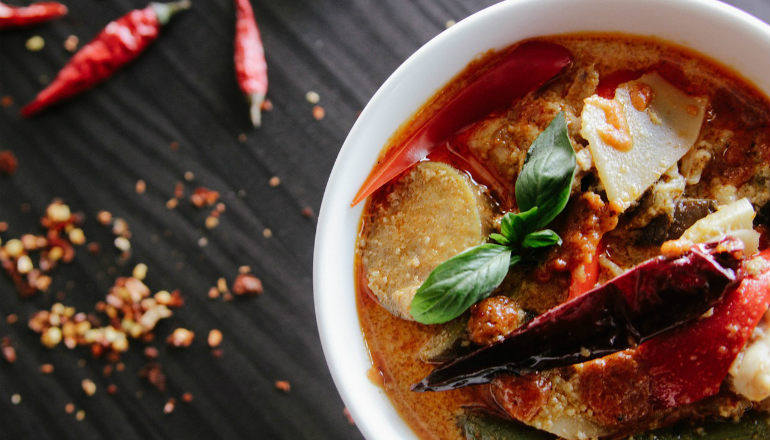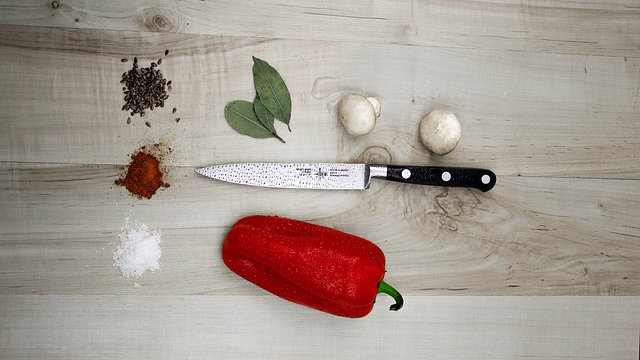
Last week, we learned how to cook our way around the world using flavor profiles. This week, we take our command of seasoning to the next level by discovering the power of taste balancing. If you have been cooking along with these lessons so far, you have been experiencing the power of taste balancing. We just haven’t been calling it that. We’ve been calling it The Starting 5, plus sour, spicy, and savory.
Now, I am going to reveal how taste balancing works so you can take complete ownership of your cooking process. Let’s start with some terms.
Taste Versus Flavor
It might surprise you to learn that the terms “taste” and “flavor” are not synonymous. The distinction between the two is important for anyone trying to develop their palate. Tastes are the big-bucket categories, while flavors are all the little items in those buckets. For instance, sour is a taste while lemon and lime are two different flavors of sour.

Five Tastes and Counting
We humans have identified five tastes: salty, sour, sweet, bitter, and umami. (If you want to read a great book that takes a deep dive into our taste buds, check out Michael Pollan’s Cooked.) While you no doubt are familiar with the first four, umami may be foreign to you. Until recently it was not recognized as a taste. It is best defined as meatiness. It’s strong in things like oysters, beef, mushrooms, butter, and olive oil.
While not technically a taste, I believe a sixth man can be added to the mix because it is perceived by the mouth. It’s called pungency. Translation: spicy. I consider spicy to be a taste, even though technically it’s just your mouth getting irritated. (This is why children don’t enjoy spicy food. Like bitterness, spicy is an acquired taste that comes with age.)
So, just as a painter only has four primary colors to work with, a chef only has five tastes to play off (or six if you count spicy). The great chefs, like the great painters, know how to use these limited options to dazzle you. A bite of food is more enjoyable when more or your taste buds light up. Just as a painting of the blue sky looks better with reliefs of white fluffy clouds and some greenery below, a taste becomes more enjoyable when counter-pointed by other tastes.

What We’ve Been Doing
Let’s take this knowledge of tastes and analyze The Starting 5 (our five spices that are universally used around the world), plus the additional three seasonings we’ve been putting in each recipe: sour, spicy, and savory.
- Salt = salty
- Pepper = spicy
- Olive oil = umami
- Onions = spicy when raw, but sweet when cooked
- Garlic = spicy when raw, but sweet when cooked
- Sour = sour
- Spicy = spicy
- Savory = wild card
You’ve been combining tastes to deliver a flavor punch with every bite of your food. But it’s been a paint-by-numbers exercise so far, with you following my “recipes.” Now, it’s time for you take the brush and start with your own blank canvas.
And just as a painter needs to know how the primary colors combine to make other colors, the key to elevating your cooking to an art form is in understanding how tastes play off each other. And that’s what we are going to cover right now.
Taste Balancing Defined
While it’s true you want to experience multiple tastes in every bite, the artistry comes with how you balance those tastes. Sweet, sour, spicy, and bitter are all balanced by each other. If you taste one stronger than the rest, consider adding some or all of the others to bring it into balance. If you are able to have all four tastes present and balanced, you have a brilliant dish on your hands.
Salty is a taste that can be reduced only by adding to the volume of non-salty ingredients. In other words, the only remedy for a dish that is too salty is to dilute it (even with water). The bummer there is that you then have to build up the other tastes again because they all get diluted, too. But you can save a salty dish by diluting and then rebuilding.
Umami is a bit of a wild card. It doesn’t balance any of the others. Salt makes it stronger. The other four cut it down. If something is too buttery, too mushroomy, too fishy, or too beefy, do not add salt, you’ll only be making it worse. Instead, cut it with any or all of the other tastes: sweet, sour, spicy, or bitter. Conversely, if you taste your dish and things are balanced, but still somehow missing something, you’re probably short on umami.
Knowing how tastes play off each other makes cooking an exciting adventure. As a chef, when you face off against any ingredient or any set of ingredients, your question is not, “Can I make this taste good?” Of course, you can! Your question should be, “How good can I make this taste?”
Skill Drill: Taste Balancing in Action

Throughout these lessons so far, we have ignored two tastes, bitter and sweet. We are going to include them in this drill, not with our seasonings, but with our choice of ingredients. We’re going to make one meal so you can really focus on the taste of it.
Ingredients:
- 1/2 serving of sweet produce — apple, pear, pineapple, mango, dates, etc.
- 1/2 serving of bitter produce — kale, arugula, broccoli, Brussels sprouts, etc.
- 1 serving of firm or soft veggies
- 1 servings of a meat or meat substitute
Note: for guidance on what constitutes a “serving size,” see lesson one.
Starting 5:
- Salt (salty)
- Pepper (spicy)
- Fat of choice (umami)
- Onion (spicy when raw, sweet when cooked)
- Garlic (spicy when raw, sweet when cooked)
- 1 thing sour — citrus, vinegar
- 1 thing spicy — peppers
- 1 thing savory — spices, dried or fresh herbs, nuts, seeds, etc.

As you look at your mix of ingredients, decide how you are going to plate them. Are you making a salad, a stir-fry, or roasted meats and veggies? Let your concept dictate how you chop your ingredients.
Chop in this order:
- Chop your produce
- Chop and/or mince seasonings
- Change cutting boards
- Chop your meat or meat substitutes

Directions:
- Set your oven to 400 degrees.
- Evaluate the primary taste each ingredient brings to the table. If you don’t know by looking at an ingredient, then taste it. (I’ll save you from having to taste raw meat by telling you it is umami.)
- Review the part of this article on taste balancing to determine what seasonings you can add to each ingredient to play off its primary taste.
- Ask yourself if any if the ingredients themselves can be used as seasoning. For instance, if you have a bitter green like arugula, pairing it with something sweet like chopped apple would be wise.
- Get as far as you can with combining the ingredients themselves to balance the taste of the dish.
- Then add The Starting 5 as you see fit before adding your sour, spicy, and savory seasonings.
If you are making a salad, you can use your dressing as an exercise in taste balancing. Here’s the equation in terms of taste:
- 3 parts umami (oil) to 1 parts sour (citrus/vinegar)
- Plus salty (salt)
- Plus spicy (pepper)
- Plus bitter
- Plus sweet
Your bitter and sweet can be ingredients. For instance, if you start with an arugula-apple combo (bitter-sweet), then adding a basic vinaigrette comprised of sour, umami, salty, and spicy will make it a winner.

If you want to taste and adjust the taste-balance throughout the cooking process, your best bet is to cook your ingredients on the stove top, which is what I recommend for this exercise. (You must not taste a dish with meat in it until the meat is fully cooked.)
Note: For a refresher on how to gauge “doneness,” read lesson one.

Plate everything up and really take time with each bite to discern all the tastes happening in your mouth. Is it balanced? What would you do differently? Can you identify your “tastes” and your “flavors”? Please post pictures and let us know how it went!
Ready for more? Dive into the rest of the lessons in this series:
- The 5 Moves to Cooking Everything: Home Cooking Boot Camp Lesson 1
- Knife Skills and Stir Fry: Home Cooking Boot Camp Lesson 2
- The 3 Essential Cooking Methods: Home Cooking Boot Camp Lesson 3
- How to Make Multiple Meals at Once: Home Cooking Boot Camp Lesson 4
- How to Organize Your Kitchen for Speed: Home Cooking Boot Camp Lesson 5
- The Power of Flavor Profiles: Home Cooking Boot Camp Lesson 6
- Learn to Play the 3 Flavor Notes: Home Cooking Boot Camp Lesson 8



































